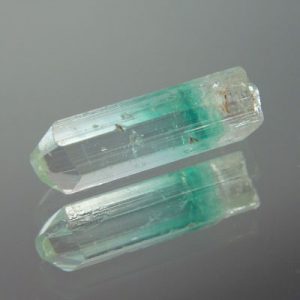Achroite
Achroite is the variety of Tourmaline that is usually colourless. The absence of colour may be as a result of the presence of Manganese (Mn) and/or Magnesium (Mg). Achroite crystals typically have well-developed faces, are elongated and striated with triangular cross sections and terminations being pyramidal. Crystal often appears fibrous or heavily included. Clean, clear, colourless crystals big enough for faceting are particularly rare. Crystals can be multi-colored from some areas. The most typical colour that is secondary green. Some crystals are colourless during the termination and base with different shades of green in the middle. Other crystals are green at the termination and colourless at the base, etc. Some Achroite gems might have a real hint that is slight of and others may be heated to eliminate the pink. Just like other Tourmaline varieties, Achroite is Piezoelectric and Pyroelectric.
Achroite was named in 1845 by Russian chemist Rudolph Hermann (1805-1879) from the Greek word άχρους (áchrous), meaning colourless or without colour. In 1855 Hermann developed his classification that is very own of which he named heterodimensional. The Vernadsky State Geological Museum in Moscow keeps the collection that is mineralogical of, totalling a lot more than 3000 samples of 900 mineral species and varieties from Europe, Russia and America. Hermann additionally discovered Chiolite and additionally named and analysed Planerite, Pyrophyllite and Turgite.
Achroite distribution: the achroite crystals that are well may be the Paprok Mine, Kamdesh District, Nuristan Province, Afghanistan. At Usakos, Karibib District, Erongo Region, Namibia. At Skardu, Skardu District, Baltistan, Gilgit-Baltistan, Pakistan. In the United States at the Mountain Lily Mine, Aguanga Hill, Oak Grove, Aguanga Mountain District, San Diego County, California. Achroite, in addition, has been reported from Bolivia, Czech Republic, England, India, Madagascar, Nepal and Sri Lanka.
| Formula: | A(D3)G6(T6O18)(BO3)3X3Z |
| Color: | Clear/Colorless |
| Lustre: | Vitreous |
| Specific Gravity: | 2.90 to 3.40 |
| Tenacity: | Brittle |
| Refractive Index: | 1.614 to 1.666 |
| Transparency : | Transparent,Translucent,Opaque |
| Fluorescence: | Weak |
| Crystal System: | Trigonal |
| Fracture: | Uneven,Conchoidal |


